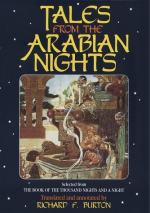Tale of Mohsin and Muss (pp. 232-241).
The notes on the story of Abu Niyyat and Abu Niyyateen (supra, pp. 356) will apply still better to the present story.
The Merchant’s Daughter,
and the Prince of Al-irak (pp.
264-317).
Pp. 305-312.—The case of Tobias and Sara (Tobit, chaps. iii.-viii.) was very similar: but in this instance the demon Asmodeus was driven away by fumigating with the liver and heart of a fish.
Arabian Nights,
Volume 15
Footnotes
[FN#1] In the same volume (ii. 161) we also find an “Introductory Chapter of the Arabian Tales,” translated from an original manuscript by Jonathan Scott, Esq. neither Ms nor translation having any meet. In pp. 34, 35 (ibid.) are noticed the ’Contents of a Fragment of the Arabian Nights procured in India by James Anderson, Esq., a copy of which” (made by his friend Scott) “is now in the possession of Jonathan Scott, Esq.” (See Scott, vol. vi. p. 451.) For a short but sufficient notice of this fragment cf. the Appendix (vol. x. p. 439) to my Thousand Nights and a Night, the able and conscientious work of Mr. W. F. Kirby. “The Labourer and the Flying Chain” (No. x.) and “The King’s Son who escaped death by the ingenuity of his Father’s seven Viziers” (No. xi.) have been translated or rather abridged by Scott in his “Tales, Anecdotes and Letters” before alluded to, a vol. of pp. 446 containing scraps from the Persian “Tohfat al-Majalis” and “Hazliyat’ Abbid Zahkani” (Facetiae of ’Abbid the Jester), with letters from Aurangzeb and other such padding much affected by the home public in the Early XIXth Century.
[FN#2] So called from Herr Uri, a Hungarian scholar who first catalogued “The Contents.”
[FN#3] W. M. Ms. iv. 165 189: Scott (vi. 238 245), “Story of the Prince of Sind, and Fatima, daughter of Amir Bin Naomaun”: Gauttier (vi. 342 348) Histoire du Prince de Sind et de Fatime. Sind is so called from Sindhu, the Indus (in Pers. Sind b), is the general name of the riverine valley: in early days it was a great station of the so-called Aryan race, as they were migrating eastwards into India Proper, and it contains many Holy Places dating from the era of the Pur n s. The Moslems soon made acquaintance with it, and the country was conquered and annexed by Mohammed bin K sim, sent to attack it by the famous or infamous Hajj j bin Y£suf the Thakafite, lieutenant of Al-’Ir k under the Ommiade Abd al-Malik bin Marw n. For details, see my “Sind Re-visited”: vol. i. chapt. viii.
[FN#4] [In Ms. “shakhat,” a modern word which occurs in Spitta Bey’s “Contes Arabes Modernes,” spelt with the palatal instead of the dental, and is translated there by “injurier.”—St.]
[FN#5] In the text “Sahr¡j”; hence the “Chafariz” (fountain) of Portugal, which I derived (Highlands of the Brazil, i. 46) from “Sak r¡j.” It is a “Moghrabin” word=fonte, a fountain, preserved in the Brazil and derided in the mother country, where a New World village is described as




